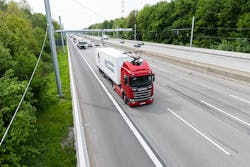Picture a hybrid electric truck that draws power, like a trolley, from overhead wires but without a fixed route determined by restrictive rails embedded in the road. That, in a nutshell, is a system developed by Siemens that’s been put into operation on 10 km (6.2 miles) of the A5 autobahn between the Frankfurt Airport and the Darmstadt/Weiterstadt interchange. It’s the first such test on a public road in Germany.
Combining the efficiency of electric rail with the flexibility of conventional road trucking, the system, called eHighway, allows trucks with special equipment mounted on their roofs to connect to electrified lines while traveling at speeds of up to 90 km per hour. When connected to the overhead lines, the trucks run on electric motors. When they return to a traditional road, a hybrid system is used. Sensors detect when the overhead wires are available.
The energy supply system is based on technology taken from railroad electrification. A two-pole catenary system ensures a reliable energy supply for the eHighway truck. No rails or other lane-guidance systems are required.
The overhead cables are used to charge the batteries of a specially developed range of Scania trucks, equipped with conductor rods, or “pantographs,” which transmit energy from the overhead contact lines to the truck’s electric motor. The pantograph can be connected to, and disconnected from, the contact wire at speeds ranging up to 90 km/h (56 mph). This is done either automatically or manually at the push of a button. Steering an eHighway truck connected to the overhead contact lines isn’t different from driving a conventional truck, as the active pantograph compensates for any shifts in position within the lane.
Pantographs can connect to electrified lines while traveling at speeds of up to 56 miles per hour.
The cables carry 670 V of dc power. However, this is only enough power to drive the truck to 90 kph on battery power alone. Power is transmitted directly from the overhead contact lines into the vehicle, enabling an optimal efficiency level of more than 80%. The trucks are able to recover braking energy and feed it back into the grid. During braking and acceleration, trucks can exchange energy with one another via the contact line, for example, on sections with hills or mountains.
Unlike trolleys and streetcars, eHighway trucks can leave the overhead line on the highway for purposes such as overtaking other vehicles or avoiding stalled vehicles. The pantograph automatically disconnects in the event of these and other, similar, evasive maneuvers.
For the remaining sections of road, the eHighway truck employs a hybrid drive (both serial and parallel concepts with internal combustion engines, battery solutions, fuel cells, etc. can all be implemented). At the end of the electrified segment of road, the truck can continue to draw from its batteries, switching to its combustion engine when fully depleted.
Carbon Reduction
Experts expect CO2 emissions from road freight traffic to more than double by 2050. According to the International Transport Forum, which is part of the Organization for Economic Co-operation and Development (OECD), road transportation of goods will account for 15% of the projected increase in global CO2 emissions.
Siemens argues that a major benefit of the eHighway system is a sharp reduction in CO2 and nitrogen-oxide emissions. The eHighway system, Siemens points out, makes it possible to reduce the use of fossil fuels and truck operating costs. The company claims that a truck owner could save over $22,000 on fuel over 100,000 km (approx. 62,000 miles).
Also, according to the Siemens, the eHighway system can be integrated and operated within the existing road infrastructure. In this case the German government spent €70 million ($77 million) to develop trucks that can use the system.
The eHighway also is said to be well-suited to connecting open pit mines with warehouses, shipment points, or processing plants using shuttle transports traveling less than 50-km distances in port or industrial areas.


